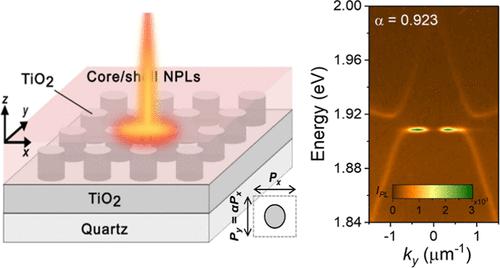连续介质中平带束缚态的室温激光
IF 16
1区 材料科学
Q1 CHEMISTRY, MULTIDISCIPLINARY
引用次数: 0
摘要
在动量空间中具有低色散的高质量因子光学模式对于低阈值激光器、强光-物质相互作用和光捕获等应用是非常理想的。连续介质中的束缚态(BICs)由于其理论上无限的质量因子,近年来作为一个有前途的光学腔概念而受到关注。然而,在动量空间中,当偏离BIC奇点时,它们的质量因子呈指数下降,这限制了它们的实际应用。在此,我们提出了一种基于二氧化钛纳米柱矩形阵列的平面带bic的设计概念和实验实现。通过精确地设计阵列中四个反传播导模之间的相互作用,可以获得一个非色散的BIC带。与方形阵列中的对称保护BIC模式相比,平带BIC模式在Γ-point附近的质量因子提高了2个数量级,并且具有异常高的光态密度。因此,我们在平坦带BIC上实现了室温激光,其质量因子为~ 9100,阈值比对称保护BIC低4倍。本文还详细研究了平面带bic激光器的方向性和拓扑电荷等特性。本研究提出的平带bic的概念和出色的激光性能标志着向高效光腔和微激光器迈出了重要的一步,并在先进的光子和光电子器件中具有巨大的潜力。本文章由计算机程序翻译,如有差异,请以英文原文为准。

Room-Temperature Lasing at Flatband Bound States in the Continuum
High-quality factor optical modes with a low dispersion in the momentum space are highly desirable for applications such as low-threshold lasers, strong light–matter interactions, and optical trapping. Bound states in the continuum (BICs) have recently gained attention as a promising optical cavity concept due to their theoretically infinite quality factors. However, their quality factor decreases exponentially when deviating from the BIC singularity in the momentum space, which limits their practical use. Here, we present a design concept and experimental realization of flatband BICs in a rectangular array of titanium dioxide nanopillars. By precisely engineering the interaction between four counterpropagating guided modes in the array, a nondispersive BIC band can be obtained. The flatband BIC exhibits an enhanced quality factor near the Γ-point by 2 orders of magnitude compared to that of the symmetry-protected BIC mode in a square array, along with an exceptionally high optical density of states. As a result, we achieve room-temperature lasing at the flatband BIC with a quality factor of ∼9100 and a threshold 4 times lower than that of the symmetry-protected BIC. The flatband-BIC lasing properties, such as directionality and topological charge, are also studied in detail. The concept and outstanding lasing performance of the flatband BICs presented in our work mark an important step toward efficient optical cavities and microlasers and hold great potential for advanced photonic and optoelectronic devices.
求助全文
通过发布文献求助,成功后即可免费获取论文全文。
去求助
来源期刊

ACS Nano
工程技术-材料科学:综合
CiteScore
26.00
自引率
4.10%
发文量
1627
审稿时长
1.7 months
期刊介绍:
ACS Nano, published monthly, serves as an international forum for comprehensive articles on nanoscience and nanotechnology research at the intersections of chemistry, biology, materials science, physics, and engineering. The journal fosters communication among scientists in these communities, facilitating collaboration, new research opportunities, and advancements through discoveries. ACS Nano covers synthesis, assembly, characterization, theory, and simulation of nanostructures, nanobiotechnology, nanofabrication, methods and tools for nanoscience and nanotechnology, and self- and directed-assembly. Alongside original research articles, it offers thorough reviews, perspectives on cutting-edge research, and discussions envisioning the future of nanoscience and nanotechnology.
 求助内容:
求助内容: 应助结果提醒方式:
应助结果提醒方式:


